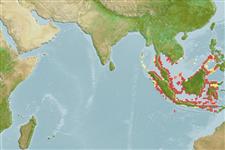Common names from other countries
Environment: milieu / climate zone / depth range / distribution range
Ecología
; rango de profundidad 0 - 1 m (Ref. 119695). Tropical; 12°N - 12°S, 91°E - 123°E (Ref. 119694)
Distribución
Países | Áreas FAO | Ecosistemas | Ocurrencias, apariciones | Introducciones
Indo-West Pacific.
Length at first maturity / Tamaño / Peso / Age
Maturity: Lm ? range ? - ? cm Max length : 100.0 cm TL macho / no sexado; (Ref. 8812); peso máximo publicado: 1.6 kg (Ref. 356)
Total Length: 89 to 100 cm; Wingspan: 206 to 230 cm (Ref. 8812). Minimum and maximum depth ranges are based on feeding behavior of dipper types of seabirds (Ref. 119695). This is to be replaced with better references. Surface feeding; scavenging; kleptoparasitism; oceanic; warm, low-salinity waters of the south Equatorial Current (Ref. 356).
Li, X. 1990. (Ref. 78638)
IUCN Red List Status (Ref. 130435)
CITES status (Ref. 108899)
Human uses
| FishSource |
Herramientas
Fuentes de Internet
Estimates based on models
Preferred temperature
(Ref.
115969): 9.1 - 20.3, mean 11.8 (based on 122 cells).
Vulnerability
High vulnerability (60 of 100).
Price category
Unknown.
